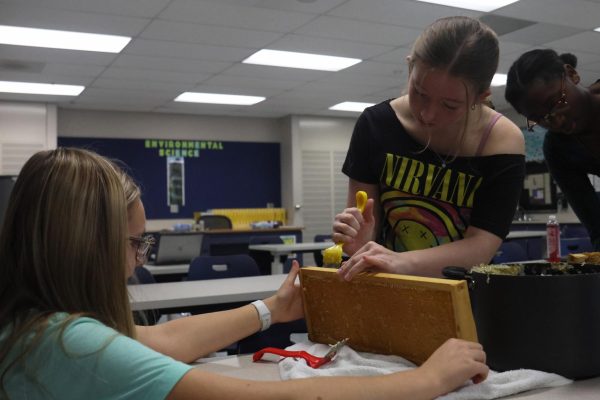The Environmental Resources and Wildlife Sciences class had their annual honey harvest this Monday, Sept. 30.
The honey comes from the beehives that the students care for as part of the course. The honey was collected and then will be filtered and stored until the honey sale. This is science teacher Kelly Prickett’s third year in the building, and second doing the harvest.

The class itself is project based, and students get to pick an area to focus on. This includes research, job shadowing and gaining real world experience. For two of Prickett’s students, this real world experience is gained by managing the beekeeping process.
“I’ve got two students that are in charge of the honey project and managing the beehives,” Prickett said. “They do a lot of research on that and inform the class on the next steps that we need to do to make sure that the hives are healthy so they can survive the winter. The other part of their project is related to the business side of how we will take that honey and sell it.”
Senior Cadence Kerr is one of those two students. In order to manage it all, the whole class is needed to effectively harvest the honey.
“Everyone helped on the honey harvest day because we had 18 frames of honey and you have to take the beeswax off of both sides,” Kerr said. “It takes a lot more than just two people working on it to get it harvested, so everybody helps out.”
The honey harvest happens once a year, so the bees can keep up their honey stores. When there is a layer of wax on top of the frames, Prickett and her class know they are ready to be harvested. This top layer also has to be scraped off before the harvest can begin.
“We’re just taking the extra honey off the top [of the hives] and leaving the rest of the honey for the bees, so they can eat that all winter, and then the whole process starts again in the spring,” Prickett said. “They start collecting and start storing in spring and

summer, and then we harvest it again in the fall.”
However, harvesting isn’t as simple as removing all of the honey from the hives. Prickett and her class have to be mindful of how the harvest will affect the health of the bees.
“They eat the honey as their food source, and that’s where they get their energy to survive the winter,” Prickett said. “They spend all summer, storing [honey] up, and then it’s supposed to get them through the winter. So we have to be careful to make sure that we do leave the right amount of honey in the hive so they don’t starve.”
Since the class harvested later than last year, Prickett was put into a tricky position.
“We’re kind of in a pinch, because we’re at the end of September and we need to start fall management but we can’t do the mite treatment until we take the honey off because we don’t want mite treatment in our honey,” Prickett said.
In order to prepare for the harvest, the whole class gets the opportunity to go down to the hive. For junior Rider Rew, this was one of the best parts of working with the bees.
“I liked all of [the process] because I got to be with friends while I was doing it, but I really liked going out there and seeing [the hives],” Rew said. “It was fun to just go out and see a bunch of bees in one place, which you really don’t see anymore.”
Seeing and managing the hives let Kerr know more about the inner workings of beehives.

(By Doreen Mahugu)
“I’ve learned what a bee hive looks like. You always think of a cartoon picture of one, but the ones that we have are a bunch of boxes stacked on top of each other. The different areas of the box also have different functions, which is something I had never known about before,” Kerr said.
For fellow senior Marissa Akehurst, meeting and working with the bees allowed for her to connect with them.
“I didn’t realize it but [bees] have their own kind of personality,” Akehurst said.
The class got new beekeeping suits this year, allowing more students to get access to the bees at a time. For Rew, the suits gave a feeling of comfort.
“I liked having the suit on. I don’t know if powerful is the right word, but it definitely made me feel protected when I was in it, even though I was around swarms of bees,” Rew said.
The suits’ coverage gave Kerr a sense of security when handling the bees.
“It is a bit scary, because it’s instinct to try and swat bees away,” Kerr said. “But you’re completely covered, so there’s no reason to. But sometimes when you’re standing out there, they buzz right past your head and you can hear them and you’re like, ‘Oh my gosh. They’re gonna get me’ but then they’ll land on the suit and everything’s fine.”
During the harvest, the honey is transferred from the frames into an extractor that strains it for the first time. The honey is strained up to three times in order to ensure nothing remains in it, and then it is stored for the year in Prickett’s classroom.

“We store it in big glass mason jars, and we keep that sealed until we’re ready to bottle it because that gives the students that are in charge of the sales a lot of time to plan the business side,” Prickett said. “It’s also kind of a nice little springtime thing to [be able to] buy your honey.”
Beyond just beekeeping, Kerr and her partner are in charge of choosing the details for how the honey will be sold later in the year. They are also in charge of how the honey will be advertised.
“We’ll make the posters for [the honey sale] and we’ll be the ones to reach out to advertise it through either the school news or MVTV, but we’ll be developing all of that,” Kerr said.
The class has given Kerr and many other students the opportunity to experience and gain knowledge about beekeeping and several other areas of wildlife science that they otherwise might not be able to.
“Beekeeping can be very expensive and you don’t necessarily collect enough money for it to be profitable,” Kerr said. “So I think it’s really fun to be able to do it in class because there’s a chance I’ll never be able to do it again.”











